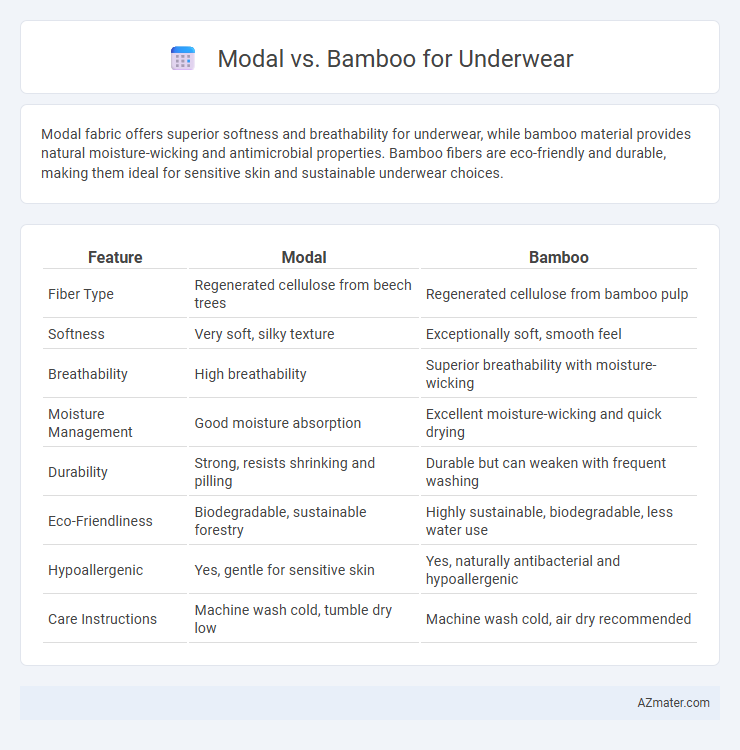Modal fabric offers superior softness and breathability for underwear, while bamboo material provides natural moisture-wicking and antimicrobial properties. Bamboo fibers are eco-friendly and durable, making them ideal for sensitive skin and sustainable underwear choices.
Table of Comparison
| Feature | Modal | Bamboo |
|---|---|---|
| Fiber Type | Regenerated cellulose from beech trees | Regenerated cellulose from bamboo pulp |
| Softness | Very soft, silky texture | Exceptionally soft, smooth feel |
| Breathability | High breathability | Superior breathability with moisture-wicking |
| Moisture Management | Good moisture absorption | Excellent moisture-wicking and quick drying |
| Durability | Strong, resists shrinking and pilling | Durable but can weaken with frequent washing |
| Eco-Friendliness | Biodegradable, sustainable forestry | Highly sustainable, biodegradable, less water use |
| Hypoallergenic | Yes, gentle for sensitive skin | Yes, naturally antibacterial and hypoallergenic |
| Care Instructions | Machine wash cold, tumble dry low | Machine wash cold, air dry recommended |
Introduction to Modal and Bamboo Fabrics
Modal fabric, derived from beech tree pulp, offers exceptional softness, breathability, and moisture-wicking properties, making it ideal for underwear designed for all-day comfort. Bamboo fabric, crafted from bamboo pulp, is highly breathable, naturally antimicrobial, and eco-friendly, providing odor resistance and temperature regulation. Both fabrics excel in sustainability and comfort, with modal known for its silky texture and bamboo prized for its antibacterial qualities.
Key Differences Between Modal and Bamboo Underwear
Modal underwear is made from beech tree fibers, offering a smooth, silky texture that excels in moisture-wicking and breathability, while bamboo underwear derives from bamboo pulp, known for its natural antibacterial properties and UV protection. Modal tends to retain color and shape better after multiple washes, making it more durable compared to bamboo, which can be softer but may lose form over time. Bamboo fabric is often more eco-friendly due to its rapid renewability and less chemical-intensive process, whereas Modal production is more resource-intensive despite its luxurious feel.
Comfort and Softness Comparison
Modal fabric offers superior softness and a smooth, silky texture that enhances overall comfort, making it ideal for underwear worn close to the skin. Bamboo fibers provide excellent breathability and moisture-wicking properties, contributing to a fresh and dry feel that complements softness for all-day comfort. Both materials excel in softness, but Modal tends to have a more luxurious touch, while Bamboo stands out for its natural hypoallergenic and eco-friendly benefits.
Breathability and Moisture-Wicking Abilities
Modal fabric offers superior breathability and moisture-wicking properties, making it an excellent choice for underwear designed to keep skin dry and comfortable throughout the day. Bamboo fabric is also highly breathable and excels at absorbing moisture, but it tends to dry slightly slower than modal. Both materials provide natural odor resistance and softness, with modal typically delivering better performance in active or high-sweat conditions.
Durability and Longevity of Modal vs Bamboo
Modal underwear offers superior durability compared to bamboo fabric due to its high tensile strength and resistance to pilling, maintaining shape and softness after multiple washes. Bamboo fabric, while naturally antibacterial and breathable, tends to wear out faster with noticeable thinning and reduced elasticity over time. Choosing modal ensures longer-lasting underwear that withstands frequent use without compromising comfort or appearance.
Environmental Impact and Sustainability
Modal fabric, derived from beech tree pulp, offers a sustainable alternative to conventional cotton due to its lower water consumption and biodegradability, making it an eco-friendly option for underwear. Bamboo fabric, known for its rapid growth and minimal need for pesticides, provides a renewable resource that supports soil health and reduces environmental footprint during production. Both materials contribute to sustainability, but bamboo's natural antibacterial properties and faster growth cycle position it as a highly renewable and environmentally responsible choice for underwear manufacturing.
Care and Maintenance Requirements
Modal underwear requires gentle care with cold water washing and low-heat drying to maintain its softness and prevent shrinkage. Bamboo underwear offers natural antibacterial properties but benefits from similar gentle washing conditions and air drying to preserve fabric integrity and longevity. Both fabrics demand avoiding harsh detergents and bleach to sustain their comfort and durability over time.
Allergen and Skin Sensitivity Considerations
Modal fabric, derived from beech tree pulp, is known for its hypoallergenic properties and breathability, making it ideal for sensitive skin and reducing allergen-related irritation. Bamboo fabric naturally possesses antibacterial and antifungal qualities, which help prevent skin allergies and soothe sensitive skin by promoting moisture-wicking and airflow. Both materials offer sustainable comfort, but bamboo's inherent antimicrobial benefits provide an added advantage for those prone to skin sensitivities and allergens.
Price Comparison and Value for Money
Modal underwear typically comes at a higher price point than bamboo due to its superior softness and moisture-wicking properties, offering excellent comfort for daily wear. Bamboo underwear provides a more budget-friendly option while still delivering benefits like breathability and natural antibacterial qualities, making it a great choice for value-conscious shoppers. Comparing price per durability and comfort, Modal often offers better long-term value despite the higher initial cost, whereas bamboo appeals for affordability with decent performance.
Choosing the Right Fabric: Modal or Bamboo Underwear?
Modal underwear offers exceptional softness, moisture-wicking capabilities, and excellent durability, making it ideal for daily wear and active lifestyles. Bamboo underwear provides natural antibacterial properties, superior breathability, and eco-friendly benefits, appealing to those seeking sustainable and hypoallergenic options. Choosing between modal and bamboo depends on whether you prioritize long-lasting fabric performance or eco-conscious, skin-friendly comfort.

Infographic: Modal vs Bamboo for Underwear
 azmater.com
azmater.com